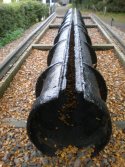 22" Atmospheric Rail GWR Preserved at Didcot |
 Torquay Pumping Station |
 Starcross Pumping Station |
Atmospheric Railways
An atmospheric railway is a railway that uses air pressure / vacuum to provide power for train propulsion. A pneumatic tube is laid between or by the side of the rails, with a piston running in it suspended from the train through a sealable slot in the top of the tube (leather seals were used). Stationary pumping engines along the route remove the air from the tube leaving a vacuum in front of the piston, and there is an arrangement for admitting air to the tube behind the piston so that atmospheric pressure propels it and the loco to which it is attached. They suffered badly from leaks but were very effecient in propelling trains up steep gradients.
The Crystal Palace atmospheric or pneumatic railway was built in 1864 at the lower end of the Crystal Palace Park, and was working for a matter of months. It ran for about 600 yards in a 10-ft diameter brick tunnel between the Sydenham and Penge gates to the Park. The tunnel had a gradient of one in 15 and the railway went round in a sharp curve. It had a coach which could seat 35, and a sliding door at each end. There was a remote steam engine coupled to a fan. The railway had a collar of bristles which made it airtight and enabled the coach to be sucked along - at a speed of probably 25 mph
An atmospheric railway system trail was held from 1840 to 1843 on a half-mile section of track adjacent to Wormwood Scrubs. This was later replaced with standard railway in 1844.
In 1844, the London and Croydon Railway built an experimental atmospheric railway. Pumping stations were built at Portland Road, Croydon and Dartmouth Road. They created a vacuum in a pipe laid between the running rails. A free piston in this pipe was attached to the train through a slit sealed by a leather seal. The piston, and hence the train, was propelled towards the pumping station by atmospheric pressure.
The initial proposal was for an 'atmospheric railway' designed by Thomas Rammell who came up with a scheme by which a stationery steam engine would drive a large fan which could suck air out of an air tight tube and draw the vehicle towards it or blow air to push them away.
The line ran from Kingstown to Dalkey in Ireland, it was just over a mile long and ran for nine years The Dalkey Atmospheric Railway started running in 1843 and was an extension of the Dublin and Kingstown Railway to Atmospheric Road in Dalkey. The line had an average uphill gradient of about 1 in 110. Vacuum power via a 15" pipe was used for the ascent to Dalkey. the return journey was by means of gravity. The vacuum tube fell short of the Dalkey station, and the train relied on momentum for the last stretch of the journey. After closure, the line was converted to the Irish standard gauge (5' 3"), the line now forms part of the DART route.
The most ambitious project as part of the South Devon Railway part of the GWR network, but only a small section was completed and used. This was from Exeter to Newton Abbot with pumping engines every 3-4 miles. The tube was 15" between borad gauge rails and the trains moved at 40mph. This section ran in 1848 only due to problems with the leather sealing flaps on the pipe. The sea spray made these flaps very poor and the pumping engines had to work much harder then was planned. This increased costs and the line was too expensive to run. The planned extension west into Cornwall was never completed and never went into service, although rail was laid with 22" pipe due to the increased gradients on this section, several pumping houses were also completed.
|
 22" Atmospheric Rail GWR Preserved at Didcot |
 22" Atmospheric Rail GWR Preserved at Didcot |
 Totnes Pumping Station |
 Surrey St Waterworks |
 Surrey St Waterworks |
Back to top










